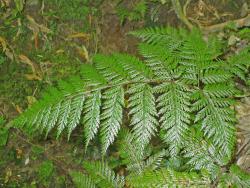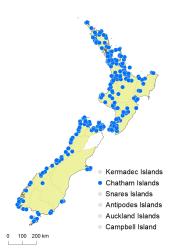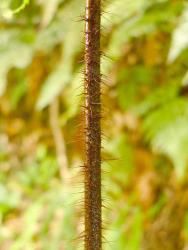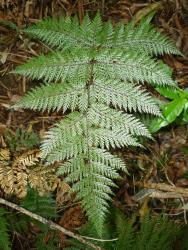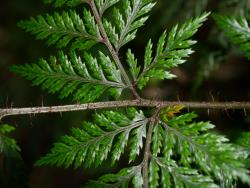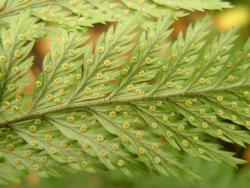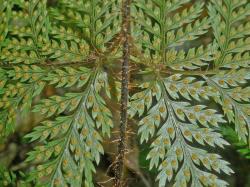- ≡ Aspidium hispidum Sw., J. Bot. (Schrader) 1800(2): 39 (1801)
- ≡ Polystichum hispidum (Sw.) J.Sm., J. Bot. (Hooker) 4: 195 (1841)
- ≡ Lastrea hispida (Sw.) Houlston & T.Moore, Gard. Mag. Bot. 3: 318 (1851)
- ≡ Nephrodium hispidum (Sw.) Hook., Sp. Fil. 4, 150 (1862)
- ≡ Dryopteris hispida (Sw.) Kuntze, Revis. Gen. Pl. 2, 813 (1891)
- ≡ Rumohra hispida (Sw.) Copel., Gen. Fil. 114 (1947)
- = Polypodium setosum G.Forst., Fl. Ins. Austr. 82 (1786) nom. illeg., non Polypodium setosum Thunb. 1784
- ≡ Polystichum schkuhrii C.Presl, Tent. Pterid. 84 (1836) nom. nov. pro Polypodium setosum G.Forst. 1786
Rhizomes long-creeping, up to 175 mm long (in herbarium material), 4–10 mm diameter, densely scaly. Rhizome scales ± linear, 4.5–17 mm long, 0.2–1.0 mm wide, dark red-brown, margins toothed. Fronds 265–1400 mm long. Stipes 120–870 mm long, red-brown proximally, pale brown distally, densely scaly and hairy; scales bristle-like with bulbous bases, almost black, up to 14 mm long and 0.5 mm wide, apices filiform, margins entire; hairs minute, stiff, red-brown, clavate, up to 0.1 mm long. Rachises pale brown, sulcate, narrowly winged only at distal end, abundantly covered in scales and hairs similar to but shorter than those of the stipes. Laminae 3–4-pinnate, or rarely 5-pinnate, ovate, 145–630 mm long, 80–400 mm wide, or rarely to 550 mm wide, brownish green on both surfaces, harsh, bearing abundant black bristle-like scales and shorter brown scales on both costa surfaces, ± colourless non-glandular hairs up to 0.4 mm long on the abaxial costae, and yellow club-shaped glands on both lamina surfaces but sparser adaxially. Primary pinnae in 12–21 pairs below pinnatifid apex, slightly overlapping; distal pinnae narrowly ovate, proximal pinnae ovate; the longest at or near the base, 60–295 mm long, 35–220 mm wide, apices acute or acuminate, bases stalked; costae narrowly winged for most of their length except on largest fronds. Acroscopic secondary pinnae decreasing evenly in length along the primary pinnae to the distal end; the basal basiscopic secondary pinna the longest, ovate, 30–130 mm long, 10–70 mm wide, apices acute, bases stalked, costae winged throughout. Tertiary segments narrowly ovate, 9–40 mm long, 2–19 mm wide, apices acute, margins sharply and deeply serrate or divided into quaternary pinnae, bases stalked. Quaternary segments narrowly ovate, up to 13 mm long and 4 mm wide, bases adnate or stalked. Sori round, nearer margin than costa; indusia reniform, 0.6–0.8 mm diameter, with a darker central area and yellow glands on the margins and surface.
Lastreopsis hispida is recognised by its long-creeping rhizomes, stipes and rachises that are densely covered in black bristle-like scales, harsh 3–5-pinnate laminae, sharply acute ultimate lamina segments, and round sori protected by reniform indusia with yellow clavate glands on the margins and surfaces.
North Island: Northland, Auckland, Volcanic Plateau, Gisborne, Taranaki, Southern North Island.
South Island: Western Nelson, Sounds-Nelson, Canterbury, Westland, Otago, Southland, Fiordland.
Chatham Islands, Stewart Island.
Altitudinal range: 0–915 m.
Lastreopsis hispida occurs in lowland and montane regions throughout the North Island from Te Paki to Wellington, except for the central high country. It grows from near sea level, to over 900 m on Tutamoe in Northland. In the South Island it is largely confined to coastal and lowland areas from the Marlborough Sounds to Fiordland and Southland. On the east coast, populations are confined to Banks Peninsula, Dunedin and the Catlins district. It reaches 520 m on the Whangamoa Saddle near Nelson. It extends also to the Chatham Islands and Stewart Island.
Also Australia (New South Wales, Victoria, Tasmania).
Lastreopsis hispida occurs as a terrestrial fern, or rarely a low epiphyte, in kauri, podocarp, broadleaved, beech and coastal forest, or under kānuka. It grows on hillsides, clay banks, streambanks, river terraces, tracksides, in rocky gullies, amongst boulders, on rotten logs, or on the forest floor. Occasionally it occurs on fallen logs and trees, or as a low epiphyte on Cyathea dealbata or C. smithii. It grows on greywacke and limestone substrates.
n = 41 (Brownlie 1958 – as Rumohra hispida).



